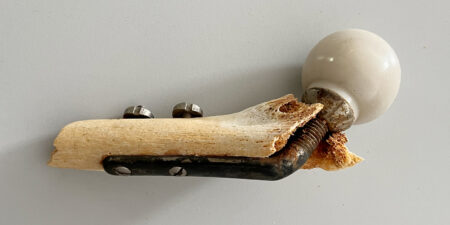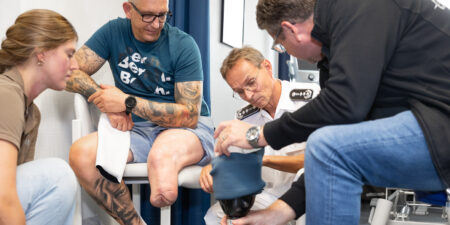With an incidence of 68.6 / 100,000, an anterior cruciate ligament (ACL) tear is still a common serious ligament injury, especially in the young and physically active patient population, and often results in chronic ligament instability of the knee joint [14].
Absence of ligament stabilisation together with medial displacement of the rotational axis of the knee joint result in significant translational instability of its lateral compartment. According to current study data, this injury can result in chronic translational instability of the knee joint in 75 – 87 % of cases after conservative treatment and in 8 – 50 % of cases after surgical management [10, 15, 16, 20]. This chronic instability has been shown to have a negative impact on the patient’s sports ability, the function of the knee joint and the patient’s quality of life, as well as towards accelerating the progression of osteoarthritis [2, 8, 14]. However, the choice of adequate treatment after an anterior cruciate ligament injury is still part of an ongoing scientific debate. In this article, we would like to take an up-to-date look at this still controversial issue, on which the Ligament Committee of the German Knee Society (DKG) has completed and published a consensus project [5, 11, 12]. According to current S1 guidelines (AWMF), ACL reconstruction using an autologous graft is indicated in cases associated with concomitant injuries to the collateral ligaments, repairable meniscal tears, and significant instability. According to meta-analyses and various cohort studies, it has been possible to reliably prevent secondary damage to the menisci and cartilage as well as to restore the previous level of activity to a large extent by ACL reconstruction [1, 9, 14].
ADEQUATE TREATMENT OF CONCOMITANT
PATHOLOGICAL CONDITIONS OFTEN REQUIRES SIMULTANEOUS ACL RECONSTRUCTION
An important prerequisite for deciding whether an ACL tear can be treated conservatively with a high probability of achieving a good result is the exclusion of relevant concomitant pathological conditions which, without surgical intervention, have a major bearing on the function and durability of the biological knee joint. The most important of these conditions is the complex meniscal tear, which has a good chance of healing after suturing but has a relevant negative impact on the joint if resected [11]. Many clinical studies have demonstrated beyond doubt the protective function of the menisci, with the lateral meniscus being of particular importance. Furthermore, the simultaneous stabilisation of the anterior cruciate ligament was shown to significantly improve the healing chances of a meniscal suture. Toman et al. demonstrated a meniscal healing rate of 70 – 92 % after simultaneous stabilisation of an ACL tear compared with a healing rate of 50 % without stabilisation [11, 17, 19]. Apart from the need to stabilise the knee joint by means of ACL reconstruction, a stem cell-promoting effect of ACL surgery to support meniscal healing is also under discussion, which is why a one-stage treatment approach is recommended.
MANAGEMENT OF AN ISOLATED ACL TEAR
With regard to the treatment of a presumed isolated ACL tear, a prospective randomised study by Frobel RB et al. in particular has received a great deal of attention, and especially the lay press has suggested an equal value of surgical and conservative treatment [3, 4]. Taking a closer look at the study, however, the fact that it reveals a change from conservative to surgical treatment after five years in 51 % of the treatment groups must be viewed very critically, given that the results of these operated patients are attributed to the conservative group. However, other studies have also shown that delayed surgical management significantly increases the risk of secondary injuries to the menisci and cartilage [6]. In their cohort study, Sanders et al. found a five-fold increased risk of secondary meniscal tears after conservatively treated ACL ruptures compared with the surgically treated group [13].
ACL RECONSTRUCTION HAS A PROTECTIVE EFFECT AGAINST SECONDARY INJURY TO THE MENISCI AND CARTILAGE
Overall, evidence thus shows that ACL reconstruction has a protective effect on menisci and cartilage and can prevent secondary injuries [11]. Another prospective randomised study was published by Tsoukas D et al. in 2013. In contrast to the Frobel study, however, this trial found an advantage in favour of surgical treatment in terms of both functional knee scores and stability values [18]. A systematic review of current studies was published in 2018 by Krause M. et al. in the German medical journal Deutsches Ärzteblatt [7]. The authors come to the conclusion that, based on the currently published RCTs (randomised controlled trials), no clear conclusion can be drawn as to whether surgical or conservative (wait and see) management leads to a better functional outcome. In observational studies, however, the authors were able to show a trend towards better results in favour of surgical management. Nevertheless, if concomitant injuries requiring urgent treatment have been ruled out and the patient has a moderate level of activity, a conservative treatment approach is primarily feasible. The patient should, however, be closely monitored and thus enable any persistent or progressive instability to be recognised in order to reconsider whether surgery is now indicated. Secondary injuries after ACL insufficiency in particular are a significant problem that can be successfully minimised by means of ACL reconstruction.
CONCLUSION
Many new findings on the impact of the peripheral ligament structures (ALL, MCL), certain meniscal pathologies, and the significance of the tibial bony slope have considerably improved our understanding of individual ACL injuries and should be increasingly taken into account in future when deciding on tailored treatment for individual patients. Apodictic “surgery or conservative therapy” should be a thing of the past. This way, it is certainly possible to improve the results of our cruciate ligament patients, whether by conservative or surgical management.
References
- Ajuied A, Wong F, Smith C, Norris M, Earnshaw P, Back D, Davies A (2014) Anterior cruciate ligament injury and radiologic progression of knee osteoarthritis: a systematic review and meta-analysis. The American Journal of Sports Medicine 42(9):2242–2252
- Filbay SR, Culvenor AG, Ackerman IN, Russell TG, Crossley KM (2015) Quality of life in anterior cruciate ligament-deficient individuals: a systematic review and meta-analysis. Br J Sports Med 49(16):1033
- Frobell RB, Roos EM, Roos HP (2010) A randomized trial of treatment for acute anterior cruciate ligament tears. … England Journal of …
- Frobell RB, Roos HP, Roos EM, Roemer FW, Ranstam J, Lohmander LS (2013) Treatment for acute anterior cruciate ligament tear: five year outcome of randomised trial. Bmj Br Medical J 346(jan24 1):f232
- Häner M, Stoffels T, Guenther D, Pfeiffer T, Imhoff A, Herbort M, Stein T, Schoepp C, Akoto R, Höher J, Scheffler S, Stöhr A, Mehl J, Niederer D, Jung T, Kittl C, Eberle C, Vernacchia C, Ellermann A, Braun P, Krause M, Mengis N, Müller PE, Best R, Achtnich A, Petersen W (2024) Management after acute injury of the anterior cruciate ligament (ACL). Part 3: Recommendation on surgical treatment. Knee Surg, Sports Traumatol, ArthroscDOI: 10.1002/ksa.12064
- Keene GCR, Bickerstaff D, Rae PJ, Paterson RS (1993) The natural history of meniscal tears in anterior cruciate ligament insufficiency. Am J Sports Med 21(5):672–679
- Krause M, Freudenthaler F, Frosch K-H, Achtnich A, Petersen W, Akoto R (2018) Operative Versus Conservative Treatment of Anterior Cruciate Ligament Rupture. Dtsch Ärzteblatt Int 115(51–52):855–862
- Lai CCH, Ardern CL, Feller JA, Webster KE (2018) Eighty-three per cent of elite athletes return to preinjury sport after anterior cruciate ligament reconstruction: a systematic review with meta-an… – PubMed – NCBI. British Journal of Sports Medicine 52(2):128–138
- Mall NA, Chalmers PN, Moric M, Tanaka MJ, Cole BJ, Bach BR, Paletta GA (2014) Incidence and Trends of Anterior Cruciate Ligament Reconstruction in the United States. Am J Sports Med 42(10):2363–2370
- Meuffels DE, Favejee MM, Vissers MM, Heijboer MP, Reijman M, Verhaar JAN (2009) Ten year follow-up study comparing conservative versus operative treatment of anterior cruciate ligament ruptures. A matched-pair analysis of high level athletes. British Journal of Sports Medicine 43(5):347–351
- Petersen W, Guenther D, Imhoff AB, Herbort M, Stein T, Schoepp C, Akoto R, Höher J, Scheffler S, Stoehr A, Stoffels T, Häner M, Hees T, Mehl J, Ellermann A, Krause M, Mengis N, Eberle C, Müller PE, Best R, Lutz PM, Achtnich A (2022) Management after acute rupture of the anterior cruciate ligament (ACL). Part 1: ACL reconstruction has a protective effect on secondary meniscus and cartilage lesions. Knee Surg Sports Traumatology ArthroscDOI: 10.1007/s00167-022-06960-1
- Petersen W, Häner M, Guenther D, Lutz P, Imhoff A, Herbort M, Stein T, Schoepp C, Akoto R, Höher J, Scheffler S, Stöhr A, Stoffels T, Mehl J, Jung T, Eberle C, Vernacchia C, Ellermann A, Krause M, Mengis N, Müller PE, Best R, Achtnich A (2023) Management after acute injury of the anterior cruciate ligament (ACL), part 2: management of the ACL‐injured patient. Knee Surg, Sports Traumatol, Arthrosc 31(5):1675–1689
- Sanders TL, Kremers HM, Bryan AJ, Fruth KM, Larson DR, Pareek A, Levy BA, Stuart MJ, Dahm DL, Krych AJ (2016) Is Anterior Cruciate Ligament Reconstruction Effective in Preventing Secondary Meniscal Tears and Osteoarthritis? American Journal of Sports Medicine 44(7):1699–1707
- Sanders TL, Kremers HM, Bryan AJ, Larson DR, Dahm DL, Levy BA, Stuart MJ, Krych AJ (2016) Incidence of Anterior Cruciate Ligament Tears and Reconstruction: A 21-Year Population-Based Study. Am J sports Med 44(6):1502–7
- Seitz H, Chrysopoulos A, Egkher E, Mousavi M (1994) [Long-term results of replacement of the anterior cruciate ligament in comparison with conservative therapy]. Chir Z fur alle Geb Oper Medizen 65(11):992–8
- Smith TO, Postle K, Penny F, McNamara I, Mann CJV (2014) Is reconstruction the best management strategy for anterior cruciate ligament rupture? A systematic review and meta-analysis comparing anterior cruciate ligament reconstruction versus non-operative treatment. The Knee 21(2):462–470
- Toman CV, Dunn WR, Spindler KP, Amendola A, Andrish JT, Bergfeld JA, Flanigan D, Jones MH, Kaeding CC, Marx RG, Matava MJ, McCarty EC, Parker RD, Wolcott M, Vidal A, Wolf BR, Huston LJ, Harrell FE, Wright RW (2009) Success of meniscal repair at anterior cruciate ligament reconstruction. The American Journal of Sports Medicine 37(6):1111–1115
- Tsoukas D, Fotopoulos V, Basdekis G, Makridis KG (2015) No difference in osteoarthritis after surgical and non-surgical treatment of ACL-injured knees after 10 years. Knee Surgery Sports Traumatology Arthroscopy 24(9):2953–2959
- Wasserstein D, Dwyer T, Gandhi R, Austin PC, Mahomed N, Ogilvie-Harris D (2013) A matched-cohort population study of reoperation after meniscal repair with and without concomitant anterior cruciate ligament reconstruction. The American Journal of Sports Medicine 41(2):349–355
- Yperen DT van, Reijman M, Es EM van, Bierma-Zeinstra SMA, Meuffels DE (2018) Twenty-Year Follow-up Study Comparing Operative Versus Nonoperative Treatment of Anterior Cruciate Ligament Ruptures in High-Level Athletes. The American Journal of Sports Medicine 46(5):1129–1136
Autoren
ist Facharzt für Orthopädie/ Unfallchirurgie und spezielle Unfallchirurgie und seit Januar 2019 in der OCM Klinik in München tätig (seit 2021 als Leitender Arzt und Gesellschafter). Seit 2016 ist er Vorstandsmitglied der Deutschen Kniegesellschaft. Außerdem ist Professor Herbort wiss. Beirat der sportärztezeitung.
ist Facharzt für Unfallchirurgie, Orthopädie und Sporttraumatologie und als Mitbegründer am Gelenkpunkt – Sport und Gelenkchirurgie Innsbruck tätig und leitet die Research Unit für Sportmedizin des Bewegungsapparates und Verletzungsprävention, an der Privatuniversität UMIT, Hall. Er war von 2002–2011 Vorstandsmitglied und zwei Jahre Präsident der AGA. Prof. Fink ist außerdem wiss. Beirat der sportärztezeitung.





